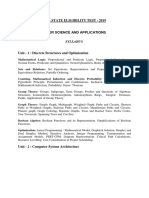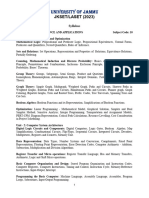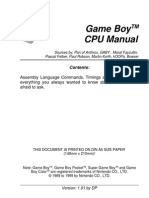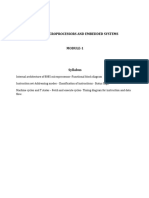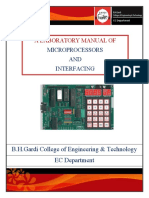0 ratings0% found this document useful (0 votes)
12 viewsComputer Science Engineering (Level 2) Syllabus
The document outlines the syllabus for a computer science engineering level 2 course. It covers topics such as operating systems, algorithms, computer organization and architecture, databases, and more. Each topic lists several subtopics and assigns them a weightage. In total, there are 4 main categories that various computer science topics are grouped under.
Uploaded by
saravananCopyright
© © All Rights Reserved
Available Formats
Download as DOCX, PDF, TXT or read online on Scribd
0 ratings0% found this document useful (0 votes)
12 viewsComputer Science Engineering (Level 2) Syllabus
The document outlines the syllabus for a computer science engineering level 2 course. It covers topics such as operating systems, algorithms, computer organization and architecture, databases, and more. Each topic lists several subtopics and assigns them a weightage. In total, there are 4 main categories that various computer science topics are grouped under.
Uploaded by
saravananCopyright
© © All Rights Reserved
Available Formats
Download as DOCX, PDF, TXT or read online on Scribd
You are on page 1/ 4
Computer Science Engineering
Level 2 Syllabus
Sr.No. Category name Subcategory name weight-age
1 Operating System 1) Basics and Processes: Concept of Operating Systems, 2
Generations of Operating systems, Types of Operating Systems,
OS Services, System Calls, Structure of an OS - Layered,
Monolithic, Microkernel Operating Systems, Concept of Virtual
Machine, Case study on UNIX and WINDOWS Operating System
Processes: Definition, Process Relationship, Different states of a
Process, Process State transitions, Process Control Block (PCB),
Context switching
Thread: Definition, Various states, Benefits of threads, Types of
threads, Concept of multithreads
2) Scheduling and IPC: Process Scheduling: Foundation and 2
Scheduling objectives, Types of Schedulers, Scheduling criteria:
CPU utilization, Throughput, Turnaround Time, Waiting Time,
Response Time, Scheduling algorithms: Pre-emptive and Non pre-
emptive, FCFS, SJF, RR, Multiprocessor scheduling: Real Time
scheduling: RM and EDF
Inter-process Communication: Critical Section, Race Conditions,
Mutual Exclusion, Hardware Solution, Strict Alternation,
Peterson’s Solution, The Producer\Consumer Problem,
Semaphores, Event Counters, Monitors, Message Passing,
Classical IPC Problems: Reader’s & Writer Problem, Dinning
Philosopher Problem etc.
Deadlocks: Necessary and sufficient conditions for Deadlock,
Deadlock Prevention, Deadlock Avoidance: Banker’s algorithm,
Deadlock detection and Recovery
3) Memory, File and Device Management: Memory 3
Management: Basic concept, Logical and Physical address map,
Memory allocation: Contiguous Memory allocation – Fixed and
variable partition– Internal and External fragmentation and
Compaction, Paging: Principle of operation – Page allocation –
Hardware support for paging, Protection and sharing,
Disadvantages of paging
Virtual Memory: Basics of Virtual Memory – Hardware and control
structures – Locality of reference, Page fault, Working Set, Dirty
page/Dirty bit – Demand paging, Page Replacement algorithms:
Optimal, First in First Out (FIFO), Second Chance (SC), Not recently
used (NRU) and Least Recently used (LRU).
I/O Hardware: I/O devices, Device controllers, Direct memory
access Principles of I/O Software: Goals of Interrupt handlers,
Device drivers, Device independent I/O software, Secondary-
Storage Structure: Disk structure, Disk scheduling algorithms;
File Management: Concept of File, Access methods, File types, File
operation, Directory structure, File System structure, Allocation
methods (contiguous, linked, indexed), Free-space management
(bit vector, linked list, grouping), Directory implementation (linear
Computer Science Engineering
Level 2 Syllabus
list, hash table), efficiency and performance
1) Algorithm Analysis: Analysis of algorithm- Characteristics of 2
algorithm, Asymptotic analysis of complexity bounds - best,
average and worst-case behavior, Performance measurements of
Algorithm, Time and space trade-offs; Analysis of recursive
algorithms through recurrence relations- Substitution method,
Recursion tree method, Masters’ theorem
2) Algorithm Strategies: Fundamental Algorithmic Strategies- 1
Brute-Force, Greedy, Dynamic Programming, Divide and Conquer,
Branchand- Bound and Backtracking methodologies for the design
Design and of algorithms, Illustrations of these techniques for Problem-
Analysis of Solving, Bin Packing, Knap Sack TSP; Heuristics- characteristics and
2 Algorithms their application domains
3) Graph and Tree Algorithms: Traversal algorithms: Depth First 2
Search (DFS) and Breadth First Search (BFS); Shortest path
algorithms- Transitive closure, Minimum Spanning Tree,
Topological sorting, Network Flow Algorithm.
4) Advance Problems: Tractable and Intractable Problems- 2
Computability of Algorithms, Computability classes – P, NP, NP-
complete and NP-hard, Cook’s theorem, Standard NP-complete
problems and Reduction techniques; Advanced Topics-
Approximation algorithms, Randomized algorithms, Class of
problems beyond NP – P SPACE
1) Computer Organization and Arithmetic: Computer 1
Architecture Fundamental Blocks- CPU, Memory, I/O Subsystems,
Control Unit; Levels of programming languages, assembly
1
language instructions, Computer Registers, Computer
Instructions, Timing & Control, Memory Reference Instructions,
Input-Output and Interrupts; Data representation- signed number
representation, fixed and floating point representations, character
representation., Computer arithmetic – integer addition and
subtraction, ripple carry adder, carry look-ahead adder,
multiplication – shift-andadd, Booth multiplier, carry save
Computer multiplier, Division restoring and non-restoring techniques,
Organization & floating point arithmetic
3 Architecture 2) Control Design and Instruction Set: Instruction Set- Instruction 1
set architecture of a CPU- registers, Instruction execution cycle
and subcycle, Instruction set, Instruction types and formats,
Instruction, Codes, RTL interpretation of instructions; Control
Design- Micro Programmed Control: Control memory, Address
sequencing, Addressing Modes, micro program , example, design
of control unit, micro-operations; Hardwire and micro-
programmed control- micro-programme sequencing, concept of
horizontal and vertical microprogramming. Hardwired & Micro
Programmed (Control Unit), Micrprogrammed; Instruction
sequencing & interpretation, computers, Microcoded CPU-
Pentium processor, Specifying a CPU, Design & implementation of
Computer Science Engineering
Level 2 Syllabus
simple CPU, General Register Organization, Stack Organization,
3) Memory and I/O Organization: Input/Output organization, 1
Peripheral devices, I/O interface, I/O ports; Interrupts- interrupt
hardware, types of interrupts and exceptions; Modes of Data
Transfer- Programmed I/O, interrupt initiated I/O and Direct
Memory Access. I/O channels and processors; Serial 1
Communication- Synchronous & asynchronous communication,
standard communication interfaces; Memory Organization:
Memory-Basic concept and hierarchy, Main memory, Auxiliary 1
memory, Associative memory, Memory Interleaving; Cache
memories: concept and design issues, associative mapping, direct
mapping, set-associative mapping, cache writing and initialization;
Mapping Functions, Write policies, Replacement Algorithm;
Pipeline and Multiprocessor: Pipeline and Vector Processing-
Parallel Processing, Pipelining, Arithmetic Pipeline, Instruction
Pipeline, RISC Pipeline, Vector Processing, Array Processors; Multi
Processors: Characteristics of Multiprocessors, Interconnection
Structures, Inter processor arbitration, Inter processor
communication, and synchronization.
1) Database System Basics: Data Abstraction, Data Independence, 2
Data Definition Language (DDL), Data Manipulation Language
(DML),
Entity-relationship model ( E-R Diagram, Extended E-R features-
DBMS Generalization, Specialization, Translating E-R model into
4
Relational model),
network model, relational and object oriented data models,
integrity constraints, data manipulation operations, Keys, Design
issues, Aggregation
DB Architecture
2) RDBMS: Relational Query Language: Relational algebra, Tuple 4
and domain relational calculus, SQL fundamentals, DDL and DML,
DCL constructs, Open source and Commercial DBMS - MYSQL,
ORACLE, DB2, SQL server; Relational database Design: Domain
and data dependency: Functional Dependencies, Non-loss
Decomposition, Multi-valued Dependencies, Join Dependencies,
Armstrong's axioms, Normal forms:First, Second, Third Normal
Forms, Boyce/Codd Normal Form, 4NF and 5 NF, Dependency
preservation, Lossless design, Evaluation of relational algebra
expressions, Query equivalence, Join strategies, Query
optimization algorithms; Storage strategies: Physical Storage
Media, File Organization, Indices, B-trees, hashing, Query
Processing Overview, Catalog Information for Cost Estimation,
Selection Operation
Computer Science Engineering
Level 2 Syllabus
1
3) Transaction processing and Database Security:
Concurrency control, ACID property, Serializability of
scheduling, Locking and timestamp based schedulers, Multi-
version and optimistic Concurrency Control schemes,
Database recovery; Authentication, Authorization and access
control, DAC, MAC and RBAC models, Intrusion detection,
SQL injection
Core Java (Module
5
ID: 1937)
You might also like
- Computer - Science - & - Engineering - 2023 10 26 17 2 54No ratings yetComputer - Science - & - Engineering - 2023 10 26 17 2 548 pages
- Computer Science and Applications - English Only - FF - 0No ratings yetComputer Science and Applications - English Only - FF - 08 pages
- JKSET Syllabus Computer Science ApplicationsNo ratings yetJKSET Syllabus Computer Science Applications6 pages
- Kerala PSC HSST Computer Science SyllabusNo ratings yetKerala PSC HSST Computer Science Syllabus5 pages
- BSC (IT) Part 1 Kolhan University Previous Year Papers and SyllabusNo ratings yetBSC (IT) Part 1 Kolhan University Previous Year Papers and Syllabus27 pages
- Higher Secondary School Teacher (Junior) (Computer Science) Kerala Higher Secondary EducationNo ratings yetHigher Secondary School Teacher (Junior) (Computer Science) Kerala Higher Secondary Education5 pages
- State Eligibility Test Computer Science and Applications (SyllabusNo ratings yetState Eligibility Test Computer Science and Applications (Syllabus9 pages
- Option - II Computer Science / Information TechnologyNo ratings yetOption - II Computer Science / Information Technology3 pages
- Database Management Systems: Course ObjectivesNo ratings yetDatabase Management Systems: Course Objectives18 pages
- Computerscience&application SyallbuskannadaNo ratings yetComputerscience&application Syallbuskannada10 pages
- 3rd Year Even: Routine & Syllabus: A B C D ENo ratings yet3rd Year Even: Routine & Syllabus: A B C D E5 pages
- Y12 End of Year Computer Science Revision ListNo ratings yetY12 End of Year Computer Science Revision List4 pages
- Unit 2: Theory of Computation: Syllabus For Competitive Examination ForNo ratings yetUnit 2: Theory of Computation: Syllabus For Competitive Examination For2 pages
- Subject Code Subject Name Credits: Overview of Computer Architecture & OrganizationNo ratings yetSubject Code Subject Name Credits: Overview of Computer Architecture & Organization4 pages
- Following Is The Amended Syllabus of B.SC (General) Course in Computer Science, University of CalcuttaNo ratings yetFollowing Is The Amended Syllabus of B.SC (General) Course in Computer Science, University of Calcutta7 pages
- Eleceng M.tech. Cse Semester I-IV Two Years CbcegsNo ratings yetEleceng M.tech. Cse Semester I-IV Two Years Cbcegs24 pages
- Programmig Ad Problem Solvig Through C': RatioaleNo ratings yetProgrammig Ad Problem Solvig Through C': Ratioale19 pages
- 102044507_Computer Architecture and Design (2) (1)_240710_095936No ratings yet102044507_Computer Architecture and Design (2) (1)_240710_0959364 pages
- Syllabus For Ph.D. Entrance Test Discrete StructuresNo ratings yetSyllabus For Ph.D. Entrance Test Discrete Structures4 pages
- Final - CSE - V Semester - New - Syllabus PDFNo ratings yetFinal - CSE - V Semester - New - Syllabus PDF13 pages
- Computer Science and Engineering Syllabus: Section 1No ratings yetComputer Science and Engineering Syllabus: Section 14 pages
- Andhra Pradesh State Eligibility Test APSET - 2019: Computer Science and Applications 05No ratings yetAndhra Pradesh State Eligibility Test APSET - 2019: Computer Science and Applications 058 pages
- Course Outline - Computer Organization and Architecture1 dt-2024-02-24 15-49-19No ratings yetCourse Outline - Computer Organization and Architecture1 dt-2024-02-24 15-49-195 pages
- Computer Skills: Understanding Computer Science and Cyber Security (2 in 1)From EverandComputer Skills: Understanding Computer Science and Cyber Security (2 in 1)No ratings yet
- Computer Science: The Complete Guide to Principles and InformaticsFrom EverandComputer Science: The Complete Guide to Principles and InformaticsNo ratings yet
- Mastering the Art of Linux Kernel Programming: Unraveling the Secrets of Expert-Level ProgrammingFrom EverandMastering the Art of Linux Kernel Programming: Unraveling the Secrets of Expert-Level ProgrammingNo ratings yet
- Computer Science: Learn about Algorithms, Cybersecurity, Databases, Operating Systems, and Web DesignFrom EverandComputer Science: Learn about Algorithms, Cybersecurity, Databases, Operating Systems, and Web DesignNo ratings yet
- 2.4 Operating Systems and Execution EnvironmentsNo ratings yet2.4 Operating Systems and Execution Environments12 pages
- ICS 2174 Intro To Computer Science 2023No ratings yetICS 2174 Intro To Computer Science 202328 pages
- Reverse Engineering of Real-Time Assembly CodeNo ratings yetReverse Engineering of Real-Time Assembly Code16 pages
- Match The Following Questions in MicroprocessorNo ratings yetMatch The Following Questions in Microprocessor10 pages
- Paharang Integrated School: Department of EducationNo ratings yetPaharang Integrated School: Department of Education6 pages
- EC1016A Microprocessors and Microcontrollers: Academic Course DescriptionNo ratings yetEC1016A Microprocessors and Microcontrollers: Academic Course Description7 pages
- CMPEN 335 - Computer Organization and Design, Lab 3: 1. PipeliningNo ratings yetCMPEN 335 - Computer Organization and Design, Lab 3: 1. Pipelining5 pages
- Simatic Readme: Validity Improvements in Step 7 Improvements in WinccNo ratings yetSimatic Readme: Validity Improvements in Step 7 Improvements in Wincc12 pages
- Computer - Science - & - Engineering - 2023 10 26 17 2 54Computer - Science - & - Engineering - 2023 10 26 17 2 54
- Computer Science and Applications - English Only - FF - 0Computer Science and Applications - English Only - FF - 0
- BSC (IT) Part 1 Kolhan University Previous Year Papers and SyllabusBSC (IT) Part 1 Kolhan University Previous Year Papers and Syllabus
- Higher Secondary School Teacher (Junior) (Computer Science) Kerala Higher Secondary EducationHigher Secondary School Teacher (Junior) (Computer Science) Kerala Higher Secondary Education
- State Eligibility Test Computer Science and Applications (SyllabusState Eligibility Test Computer Science and Applications (Syllabus
- Option - II Computer Science / Information TechnologyOption - II Computer Science / Information Technology
- Unit 2: Theory of Computation: Syllabus For Competitive Examination ForUnit 2: Theory of Computation: Syllabus For Competitive Examination For
- Subject Code Subject Name Credits: Overview of Computer Architecture & OrganizationSubject Code Subject Name Credits: Overview of Computer Architecture & Organization
- Following Is The Amended Syllabus of B.SC (General) Course in Computer Science, University of CalcuttaFollowing Is The Amended Syllabus of B.SC (General) Course in Computer Science, University of Calcutta
- Eleceng M.tech. Cse Semester I-IV Two Years CbcegsEleceng M.tech. Cse Semester I-IV Two Years Cbcegs
- 102044507_Computer Architecture and Design (2) (1)_240710_095936102044507_Computer Architecture and Design (2) (1)_240710_095936
- Syllabus For Ph.D. Entrance Test Discrete StructuresSyllabus For Ph.D. Entrance Test Discrete Structures
- Computer Science and Engineering Syllabus: Section 1Computer Science and Engineering Syllabus: Section 1
- Andhra Pradesh State Eligibility Test APSET - 2019: Computer Science and Applications 05Andhra Pradesh State Eligibility Test APSET - 2019: Computer Science and Applications 05
- Course Outline - Computer Organization and Architecture1 dt-2024-02-24 15-49-19Course Outline - Computer Organization and Architecture1 dt-2024-02-24 15-49-19
- Computer Skills: Understanding Computer Science and Cyber Security (2 in 1)From EverandComputer Skills: Understanding Computer Science and Cyber Security (2 in 1)
- Computer Science: The Complete Guide to Principles and InformaticsFrom EverandComputer Science: The Complete Guide to Principles and Informatics
- Mastering the Art of Linux Kernel Programming: Unraveling the Secrets of Expert-Level ProgrammingFrom EverandMastering the Art of Linux Kernel Programming: Unraveling the Secrets of Expert-Level Programming
- Computer Science: Learn about Algorithms, Cybersecurity, Databases, Operating Systems, and Web DesignFrom EverandComputer Science: Learn about Algorithms, Cybersecurity, Databases, Operating Systems, and Web Design
- Paharang Integrated School: Department of EducationPaharang Integrated School: Department of Education
- EC1016A Microprocessors and Microcontrollers: Academic Course DescriptionEC1016A Microprocessors and Microcontrollers: Academic Course Description
- CMPEN 335 - Computer Organization and Design, Lab 3: 1. PipeliningCMPEN 335 - Computer Organization and Design, Lab 3: 1. Pipelining
- Simatic Readme: Validity Improvements in Step 7 Improvements in WinccSimatic Readme: Validity Improvements in Step 7 Improvements in Wincc









